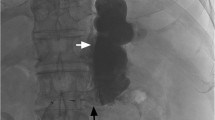Abstract
Purpose
To determine whether pretreatment portal flow direction can predict different clinical manifestations or prognosis after balloon-occluded retrograde transvenous obliteration (B-RTO) for gastric varices.
Methods
The subjects were 103 cirrhotic patients with medium- or large-grade gastric varices treated by B-RTO. Short- and long-term clinical outcomes were compared among patients with forward portal flow (F group) and those with reversed or to-and-fro portal flow (R group) on color Doppler sonography before B-RTO.
Results
Deterioration of liver function reserve 1 year after B-RTO was more frequent in the R group (34.7 %) than in the F group (11.1 %, p = 0.0251). Thrombotic disorders within 1 year after B-RTO were also more frequent in the R group (20.7 %) than in the F group (2.7 %, p = 0.0079). There was no significant difference in cumulative survival rate of Child class A patients between the two groups. In Child class B or class C patients, however, the cumulative survival rate was poorer in the R group (68.7, 30.5, and 30.5 % at 1, 5, and 9 years, respectively) than in the F group (94.9, 58.8, and 37.8 % and 1, 5, and 9 years, respectively; p = 0.0097).
Conclusions
Hemodynamic assessment of portal flow direction is important before B-RTO, and care should be taken to manage thrombotic disorders in the perioperative period in patients with reversed portal flow after B-RTO. Another treatment option might be preferred for gastric varices in Child classes B and C patients with reversed portal flow instead of B-RTO, which may have a poor prognosis.



Similar content being viewed by others
References
Kim T, Shijo H, Kokawa H, et al. Risk factors for hemorrhage from gastric fundal varices. Hepatology 1997;25:307–312
Trudeau W, Prindiville T. Endoscopic injection sclerosis in bleeding gastric varices. Gastrointest Endosc 1986;32:264–268
Sarin SK, Sachdev G, Nanda R, et al. Endoscopic sclerotherapy in the treatment of gastric varices. Br J Surg 1988;75:747–750
Sarin SK, Lahoti D, Saxena SP, et al. Prevalence, classification and natural history of gastric varices: a long-term follow-up study in 568 portal hypertension patients. Hepatology 1992;16:1343–1349
Akiyoshi N, Shijo H, Iida T, et al. The natural history and prognostic factors in patients with cirrhosis and gastric fundal varices without prior bleeding. Hepatol Res 2000;17:145–155
Kimura K, Ohto M, Matsutani S, et al. Relative frequencies of portosystemic pathways and renal shunt formation through the “posterior” gastric vein: portographic study in 460 patients. Hepatology 1990;12:725–728
Kanagawa H, Mima S, Kouyama H, et al. Treatment of gastric fundal varices by balloon-occluded retrograde transvenous obliteration. J Gastroenterol Hepatol 1996;11:51–58
Koito K, Namieno T, Nagakawa T, et al. Balloon-occluded retrograde transvenous obliteration for gastric varices with gastrorenal or gastrocaval collaterals. AJR Am J Roentgenol 1996;167:1317–1320
Hirota S, Matsumoto S, Tomita M, et al. Retrograde transvenous obliteration of gastric varices. Radiology 1999;211:349–356
Chikamori F, Kuniyoshi N, Shibuya S, et al. Eight years of experience with transjugular retrograde obliteration for gastric varices with gastrorenal shunts. Surgery 2001;129:414–420
Ninoi T, Nishida N, Kaminou T, et al. Balloon-occluded retrograde transvenous obliteration of gastric varices with gastrorenal shunt: long-term follow-up in 78 patients. AJR Am J Roentgenol 2005;184:1340–1346
Hiraga N, Aikata H, Takaki S, et al. The long-term outcome of patients with bleeding gastric varices after balloon-occluded retrograde transvenous obliteration. J Gastroenterol 2007;42:663–672
Maruyama H, Okugawa H, Kobayashi S, et al. Pre-treatment hemodynamic features involved with long-term survival of cirrhotic patients after embolization of gastric fundal varices. Eur J Radiol 2010;75:e32–e37
Maruyama H, Ishihara T, Ishii H, et al. Blood flow parameters in the short gastric vein and splenic vein on Doppler ultrasound reflect gastric variceal bleeding. Eur J Radiol 2010;75:e41–e45
Okugawa H, Maruyama H, Kobayashi S, et al. Therapeutic effect of balloon-occluded retrograde transvenous obliteration for gastric varices in relation to haemodynamics in the short gastric vein. Br J Radiol 2009;82:930–935
Tajiri T, Yoshida H, Obara K, et al. General rules for recording endoscopic findings of esophagogastric varices (2nd edition). Dig Endosc 2010;22:1–9
Groszmann RJ, Glickman M, Blei AT, et al. Wedged and free hepatic venous pressure measured with a balloon catheter. Gastroenterology 1979;76:253–258
Barth KH, Udoff EJ. Transfemoral balloon catheterization for hepatic wedge pressure measurements. Radiology 1980;135:779–780
Shimoda R, Horiuchi K, Hagiwara S, et al. Short-term complications of retrograde transvenous obliteration of gastric varices in patients with portal hypertension: effects of obliteration of major portosystemic shunts. Abdom Imaging 2005;30:306–313
Kumar DR, Hanlin E, Glurich I, et al. Virchow’s contribution to the understanding of thrombosis and cellular biology. Clin Med Res 2010;8:168–172
Author information
Authors and Affiliations
Corresponding author
Rights and permissions
About this article
Cite this article
Kamezaki, H., Maruyama, H., Shimada, T. et al. Short- and long-term clinical outcome after balloon-occluded retrograde transvenous obliteration: is pretreatment portal flow direction a predictive factor?. Hepatol Int 7, 241–247 (2013). https://doi.org/10.1007/s12072-012-9376-1
Received:
Accepted:
Published:
Issue Date:
DOI: https://doi.org/10.1007/s12072-012-9376-1




